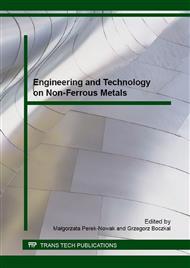p.239
p.245
p.252
p.259
p.265
p.270
p.276
p.284
p.293
Influence of Molybdenum and Boron Addition on Fracture of P/M Parts
Abstract:
Samples made of iron powder with addition of 1.5 and 2% of molybdenum and 0-0.6% of boron were compacted at 600 MPa and sintered at 1200°C for 60 minutes in hydrogen atmosphere after mixing in Turbula mixer. The samples were deformed in a tensile test till rupture. The effect of molybdenum and boron on topography of fracture is discussed. It is noted that the sintering mechanism changes upon addition of boron particles into Fe-Mo alloy. The fractures of the studied samples were observed by means of scanning electron microscopy (SEM) and energy dispersive spectroscopy (EDS). The addition of Mo influences the change of fracture to ductile type. The type of fracture is brittle with Mo and borides segregating to grain boundaries. In the alloys with low concentrations of molybdenum boron induces brittle transgranular fracture.
Info:
Periodical:
Pages:
265-269
Citation:
Online since:
February 2016
Authors:
Keywords:
Price:
Сopyright:
© 2016 Trans Tech Publications Ltd. All Rights Reserved
Share:
Citation:


